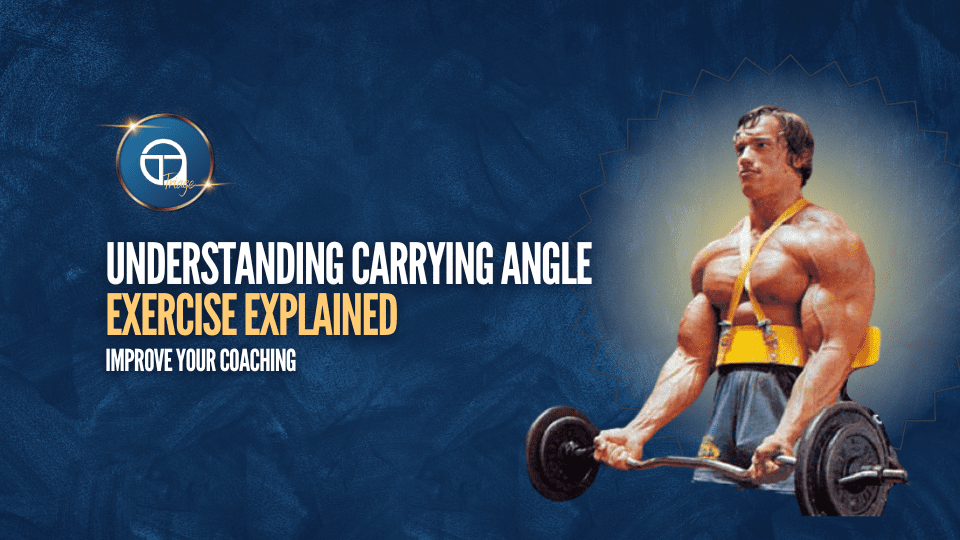Carrying angle is an interesting anatomical phenomenon or anatomical variation that occurs between individuals, especially between men and women. The carrying angle is effectively the angle between the line that runs from the shoulder down through the centre of the humerus to the upper arm and the lower arm. Its the angle between the line that would be created if the upper arm line was to continue down through the forearm, and the actual forearm. For most people, it’s not a perfectly straight line. There’s some sort of increase in the angle as it runs out from the side of the body.
Understanding Carrying Angle
Now, if you think of why that might be, and why that difference might exist between men and women, well, if you think about the typical kind of anthropometry of men and women, typically women are going to have broader hips and narrower shoulders. That’s kind of the typical difference you see, whereas men will typically have broader shoulders and narrower hips. So, in women, it would obviously make sense then, as a result, that their carrying angle would be a little bit wider because they need to be able to carry things outside the width of their hips and to have their arms be able to clear their hips when by their sides. Now, while there’s a sex difference here, there is also a difference between individuals, and this stuff does exist on a spectrum. Not all individuals are going to follow that exact general difference and that every man you encounter is going to have a smaller carrying angle than every woman you meet.
Now, why it matters is because this might come up as a variable of interest when you’re doing certain exercises such as bicep curls, for example. Because when you set up someone on a straight bar bicep curl, and you get them to grab the bar at shoulder width, people with different carrying angles are going to experience that differently. if I get someone with a large carrying angel to hold the bar at shoulder width, then in the bottom position, then it’s kind of forcing them into this position that isn’t necessarily following his carrying angle. Whereas using a wider grip would be better aligned with their larger carrying angle in the bottom position.
Now, this may matter, or it may not matter. Where these things begin to matter is when the individual is experiencing problems with the exercise, especially pain related to performing the exercise. Now, it’s not necessarily the case that you have to wait till someone’s in pain during an exercise to make some sort of change. If someone is saying that they actually find it really uncomfortable to hold a straight bar, they find it really uncomfortable to try and hold their arms, hands and shoulders all in that straight line, and when they use dumbbells it feels much better. Well, sometimes that can be because of that carrying angle.
Now, obviously, there’s a difference between external rotation and carrying angle, and someone could be very externally rotated and curling up and the hand is then outside of their shoulder width, and think that is a result of their carrying angle. However, just because your hand ends up outside of shoulder distance doesn’t mean that that’s due to carrying angle because you do actually have to make sure that the bicep, the pit of the elbow (the cubital fossa), that’s facing forward when you’re looking at it. So, if you were to look down on the humerus here, someone with a larger carrying angle will see that there’s an angle to the side. If someone has a larger carrying angle, then you won’t see it going in that perfect straight line that we would kind of expect if someone was doing a basic bicep curl.
This seems like one of those kind of nuanced things that may never matter, and it’s just an interesting anatomical variation, but it may indeed matter for certain clients. Especially if they have a very large carrying angle and they’re already telling you that this particular exercise is quite uncomfortable for them, then it might be wise to give them a bit more freedom in terms of their ability to move. That could mean using something like a cable variation, so you could use handles that are freely movable, or you could use dumbbells that are freely movable, or you could just play around with the grip width and see how that actually changes the experience of the exercise.
At the end of the day, it’s all about ensuring that people are enjoying their exercise experience while still training hard, of course. It’s also about ensuring that they’re going to be in the game for the long run. We ultimately want to find the exercises that are most enjoyable, most sustainable, and most productive from a results perspective. So, if that is being hindered by someone being really uncomfortable during an exercise, not enjoying it, being in pain, or whatever, that’s obviously not in line with our goals as trainers. Think about where that might apply, and remember, it’s all about applying this to your clients who need it. It doesn’t necessarily apply to everyone, but it might apply to a few, and it could be those clients that you need to help the most.
You can stay up to date with our content by subscribing to our email newsletter and our YouTube channel. If you need more specific help with your own training, then we do have online coaching spaces available. We also have a comprehensive nutrition certification course that can really help you to upskill your knowledge of nutrition and thus help more clients.

